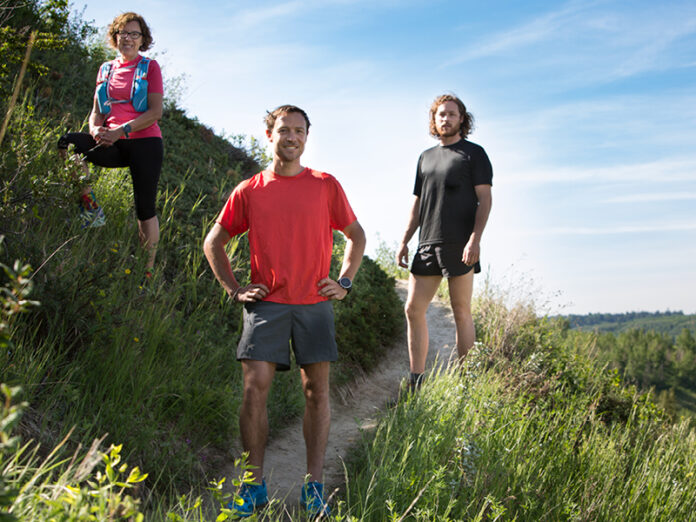
In the middle of an epic Rocky Mountain trail run, Adam Campbell placed his hand on a boulder the size of a small fridge to lever himself up. The rock pulled free and pitched him into a terrifying fall.
“The whole rock came out and sent me falling about 200 feet. I thought I was dead,” the 37-year-old says of the incident last summer. “I still have vivid flashbacks.”
The Calgary lawyer was with fellow ultra runners Nick Elson and Dakota Jones in Rogers Pass, B.C., doing a traverse linking 13 mountains. They had harnesses, ropes, crampons, helmets, ice axes, emergency gear and food.
But being well-equipped and in the company of experienced runners isn’t always preparation enough in nature’s playground.
As Campbell rag-dolled down the mountain, the terrain delivered a merciless assault on his body – discarding him face-down on the ground in a pile of scree and pool of blood. “They thought they were coming down to a corpse because they watched me fall,” he says.
Whether it’s a twisted ankle that leaves you limping, encountering wildlife, getting lost or a slip sending you off a ridge, trail running dangers come in many forms. You must be ready for anything.
You’re pushing your luck if you hit the trails unprepared, says ultra runner Ian MacNairn.
“How much do you value life?” he asks. “To me, safety is the ultimate concern when going out.”
The 29-year-old athlete and medical student, who survived being hit by a car several years ago, competes around the world today. His key piece of safety equipment is a GPS locator, should he need to summon help and, as a Type 1 diabetic, he carries plenty of food.
One trek down a mountain in 2014, MacNairn felt his blood sugar plummet. He ate the last of the food he had packed, but it wasn’t enough and in a desperate, drunken-like diabetic state where vision blurs and the body goes weak, he struggled to get to his truck.
“It feels like what hitting the wall is – total physical, mental and emotional collapse and if you have diabetes, it continues on to coma and death,” says MacNairn, notorious for social media posts showing off spectacular trails around the world and bruised and battered body parts he has accumulated along the way. “The only solution is more food and the only food was in my truck. It was extremely terrifying. I’m by myself, I’m laying half-conscious on the trail, walking a few steps and falling down. I could die right here, right now. My personal struggle is having diabetes. There’s not much room for error.”
Ultra trail runner Gavin Grobbelaar endeavours to dodge dangers inherent to his sport by making safety a top priority. The South African, who moved to Canada two years ago, is always eager to amend his arsenal.
“The whole bear thing is really new to me,” the 34-year-old says. “I didn’t even know bear spray existed. It’s like saying, ‘Take your lion spray with you.’ In South Africa, we stay away from wildlife.”
Bear aware as he might be, it was a nasty fall that offered a painful reminder of hazards on the trails and how quickly things can get ugly.
“I did a forward flip off the side and dropped quite a long ways down. I didn’t even touch the ground, the momentum took me,” he says of the mishap encountered when he lost his footing while running along a sheer ridge at Grotto Mountain near Canmore. “It knocked the wind out of me and I could barely move. My body was in absolute agony.”
Four hours later, taking four times the amount of time he normally would, he had dragged himself down the trail before calling a friend to fetch him. Fortunately, nothing was broken, but there was enough damage to keep Grobbelaar out of the game for several months.
“I am a firm believer in not being stupid about it and not taking unreasonable risks,” he says. “But there is always that element of risk.”
Grobbelaar says those who spurn safety do so at their peril. So-called “weight weenies,” for instance, cut labels off packs and clothing and carry less gear to increase efficiency.
“A lot of runners are trying to go higher and faster and taking certain risks and sacrifice a certain safety for efficiency,” says Grobbelaar, operations manager with the Calgary Marathon. “You are hearing of more accidents in the mountains with (trail running) starting to become an extreme sport. Like with any sport, some will push the limits. I’m a big believer in being safe.”
So is endurance runner Gary Robbins, a Newfoundlander who lives in North Vancouver, B.C., and has had close calls of his own and knows of too many lives lost to fatal outings.
“I would say shelter and communication are the two main things,” says Robbins.
In 2011, he heard his foot break while on the trails in Hawaii. Without a phone, in an area where there was cell phone service, he was forced to walk until he found someone to summon help.
On the same vacation, a runner who was lost “actually perished because they couldn’t safely find their way out of the mountains and tried to take a shortcut and fell to their death,” he says.
For the athlete who braved the infamous Barkley Marathons this spring and regularly competes in 100-mile events, the traumatic experience of hopping and hobbling two kilometres to find help, combined with the tragedy to befall others was an eyeopener.
Robbins and his wife made a pact to always carry cell phones and, when venturing out of service range, to carry a SPOT GPS tracker. He shares safety tips as often as he can.
“I recognized how rapidly things can go wrong,” Robbins says. “If something goes wrong, I don’t need to solve it myself. I can sit still and wait for people to come to me.”
Verna Crosson and her daughter, Kathy Rothwell did not have that luxury when they got lost after dark in Kananaskis Provincial Park.
The 62-year-old triathlete, who has been trail running for about seven years, and her daughter planned to run 22K west of Calgary last November but that changed when the trail beneath disappeared in fresh snow.
“We were kind of looking for the trail and ended up following a fire road and then it ended. So, we started following animal trails, which is really stupid, and they would go for a while and then they would end,” she says, recalling the guilt of bringing her daughter along for the ill-fated outing.
“You are the mom and you are supposed to protect them. If I would have been there myself, I would have been, ‘Whatever, I will survive.’ But I felt responsible for Kathy.”
Backtracking eventually brought them to their car, but it was a dark and cold walk up steep, icy hills to get there.
“Then it kind of hits you. OK, we are so fortunate. It could have turned out bad,” Crosson says.
Campbell, who shares his mountain-plunge ordeal in an emotional TEDx Talk, is acutely aware not everyone gets second chances when encountering dangers on the trails.
He cherishes his punishing climb back from the edge when one step too far sent him on a death-defying journey.
As he slipped in and out of consciousness that devastating day, Campbell lay in unbearable pain with his body covered in lacerations, many down to the bone. One friend climbed up to a peak to get cell service to summon help while the other rushed to Campbell’s side.
“I don’t believe what happened to me was bad luck. The second you put yourself out there in a somewhat risky environment … the mountains will always win,” Campbell says.
“There is a risk doing what we do. The more education you can get about mountain travel, the better you will be. Moving through mountains can be wonderful, but can also be quite dangerous. Go out and explore but do be careful out there.”

Staying Safe on the Trails
- Before you leave – notify someone where you are going and when you plan to return
- Carry a map
- Go in groups if possible
- Research weather conditions and any warnings, like avalanche and wildlife
- Get educated – study up on everything from avalanche awareness to CPR training and backcountry travels
















